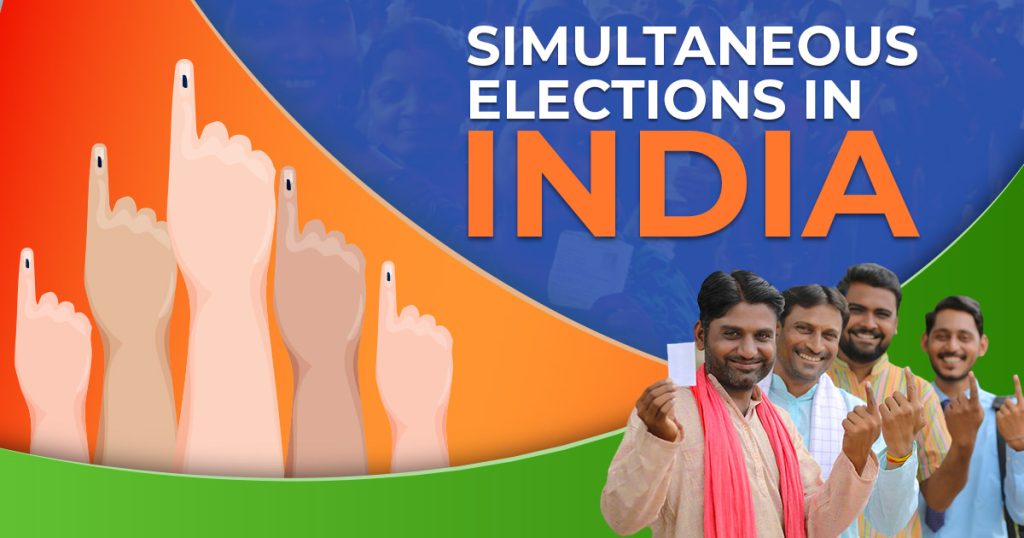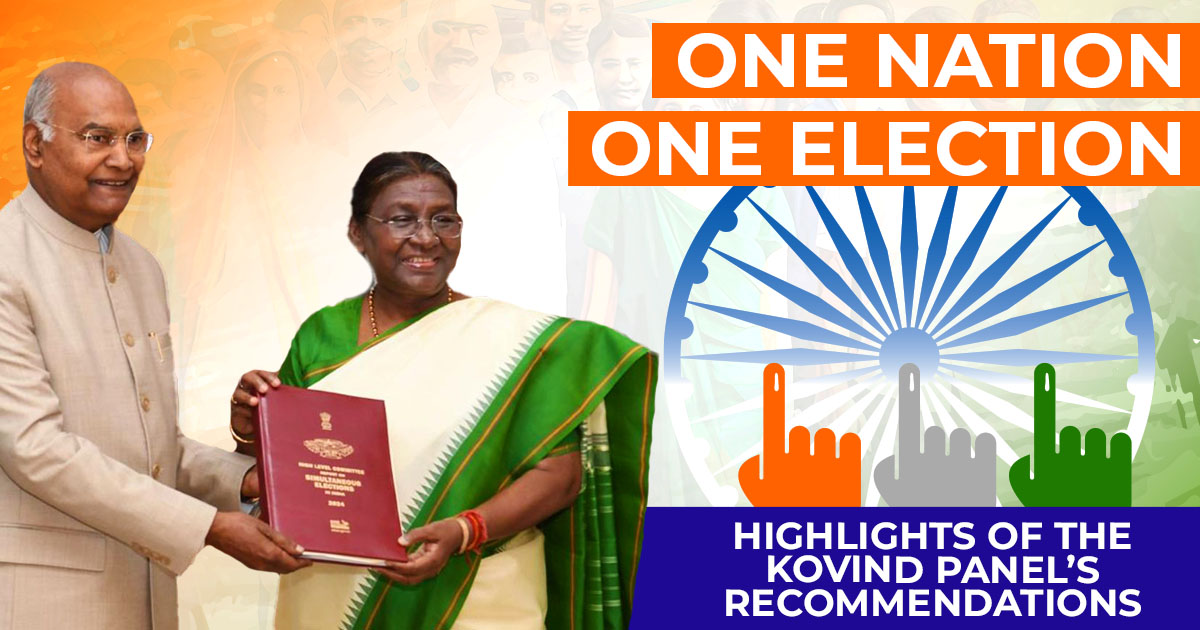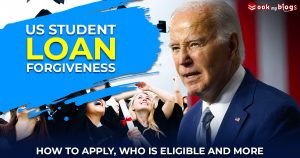On 14th March 2024, the Kovind panel submitted a recommendation of Simultaneous Election or “One Nation, One Election” to the president of India, Draupadi Murmur at Rashtrapati Bhavan.
What Is Simultaneous Elections?
Simultaneous Election is a process when all the elections from Lok Sabha, State Assemblies, Panchayat, and Municipalities are conducted at the same time across the nation.
The simultaneous polls are expected to accelerate development and social cohesion, deepen the “foundations of the democratic rubric” and finally lead to the much-needed “fundamental transformation” in Indian Politics. The “One Nation, One Election” can be started from 2029.
India can be considered perennially in election mode as around 5-7 elections are happening every year.
The former President Pranab Mukherjee had shed light on the need for simultaneous elections, by stating- “With some election or the other throughout the year, the normal activities… come to a standstill…If political parties collectively think, we can change it.”
What Has The Committee Recommended?
This 18,626-page report having 21 volumes, 11 chapters along with the Annexure recommends simultaneous election for Lok Sabha, State assemblies, and Local Bodies including panchayats and municipalities across the nation.
- Restoring simultaneous elections:
The discontinuity in conducting simultaneous elections after independence has brought various negative impacts on the Indian economy and politics. This is because holding multiple elections throughout the year impacts the economy, politics, and society as a whole.
- Two-step approach:
This will be implemented in two steps. In the first step, simultaneous elections from Lok Sabha and State Legislative assemblies will be conducted.
In the second step, election for municipalities and panchayat will be conducted with the Lok Sabha and State Assembly polls within the time frame of 100 days
- Notification by the President:
The president needs to set an appointed date through a notification issued on the first sitting of Lok Sabha after a general election. This appointed date will be the date of the start of the electoral cycle.
- Tenure of state legislative assemblies:
The committee recommended that the tenure of State Legislative Assemblies should end with the subsequent General elections to the House of the People after the Appointed date.
- Implementation group:
An Implementation Group should be constituted to oversee the execution of the recommendations.
- Constitutional amendments:
This may require some amendments to the constitution such as the introduction of Article 324A for simultaneous elections in panchayats and municipalities and amendments in Article 325 for one electoral roll and a single elector’s photo identity card. Their amendments in the Constitution require ratification by the state.
- Single electoral roll and identity card:
This single electoral roll and electoral photo identity card (EPIC) is recommended for all three tiers of the Indian Government.
- Handling emergencies:
In case of a hung house or no-confidence motion, fresh elections may be conducted for a new house. This will need amendments in Article 83 and Article 172 without state ratification.
- Logistical planning:
The Election Commission of India along with State Election Commissions should draw up plans and estimates in advance for logistical arrangements, including the procurement of equipment like EVMs and VVPATs, and the deployment of polling personnel and security forces.
Responses On Simultaneous Elections
This “one nation, one election” report came out as a result of 191 days of extensive consultation with the stakeholders and in-depth research studies. These consultations started from 2nd September 2023.
The high-level Kovind committee presented this report in front of Union Home Minister Amit Shah, Union Law Minister Chief Gulam Nabi Azad of Arjun Ram Meghwal, Democratic Progressive Azad Party (DPAP), and other delegates.
People’s Response
India being a democratic country “by the people, for the people and of the people”, the people were also asked to give their opinions. A public notice was published in newspapers across the country and 21558 responses were recorded through it. 80% of the people of India supported this recommendation.
Political Parties Response
As a part of the consultation, 47 political parties submitted their responses of which 32 parties supported this One Nation, One Election proposal. 15 political parties did not give any response on this after various requests.
Let’s look at which political parties were in favor or against the One Nation One Election proposal;-
| Parties in Favour | Parties in Opposition |
| Bharatiya Janata Party | Aam Aadmi Party |
| National People’s Party | Bahujan Samaj Party |
| All India Anna Dravida Munnetra Kazhagam | Communist Party of India (Marxist) CPI (M |
| All Jharkhand Student Union (AJSU) | Indian National Congress |
| Apna Dal (Soney Lal) | All India United Democratic Front |
| ASOM Gana Parishad | All India Trinamool Congress |
| Biju Janata Dal | All India Majilis-EIttehadul Muslimeen |
| Janata Dal (United) | Communist Party of India (CPI) |
| Lok Jan Shakti Party (R) | Dravida Munnetra Kazhagam (DMK) |
| Mizo National Front | Naga People’s Front (NPF) |
| Shiv Sena | Samajwadi Party |
| Sikkim Krantikari Morcha | Marumalarchi Dravida Munnetra Kazhagam (MDMK) |
| Shiromani Akali Dal | Viduthalai Chiruthaigal Katchi |
| United People’s Party | Communist Party of India (MarxistLeninist) Liberation |
| Pattali Makkal Katchi | Social Democratic Party of India |
| Republican Party of India (Athawale) (RPI(Atwl)) | |
| Tamil Maanila Congress (M) | |
| Rashtriya Lok Janata Dal | |
| United Kisan Vikas Party | |
| Bharatiya Samaj Party | |
| Gorakha National Liberal Front | |
| Hindustani Aavam Morcha | |
| Indian Makkal Kalvi Munnetra Kazhagam | |
| Indigenous People’s Front of Tripura | |
| Jan Surajay Shakti | |
| Rashtriya Lok Jan Shakti Party | |
| Maharashtrawadi Gomantak Party | |
| Nishad Party | |
| Puthia Nidhi Katchi | |
| Rashtrawadi Congress Party (Ajit Pawar) | |
| Democratic Progressive Azad Party |
Is This The First Time Simultaneous Elections Are Proposed in India?

The Cycle of Simultaneous Elections started in 1951-52 and continued till the year 1967. However, because of the premature dissolution of a few legislative assemblies during 1968-69, the simultaneous elections were disrupted.
In 1983, the Election Commission in its annual report recommended that Lok Sabha and State Legislative Assemblies could be held simultaneously. Moreover, the Law Commission head, Justice B.P. Jeevan Reddy also mentioned in the 170th Report of May 1999 that “we must go back to the situation- where elections to Lok Sabha and all the Legislative Assemblies are held at once”. It was reiterated in the 79th Report of the Parliamentary Standing Committee (2015) and NITI Aayog paper in 2017
Earlier in 2019, an all-party meeting was held in Delhi. One of the main subjects of discussion during this meeting was simultaneous elections. A total of 19 political parties were part of this meeting out of which 16 supported the simultaneous elections, while only three political parties were against it.
Here is the detailed list of parties who were in favor and who were against it:-
| Parties in Favour | Parties in Opposition |
| Bharatiya Janata Party (BJP) | Communist Party of India (Marxist) |
| Nationalist Congress Party (NCP) | Revolutionary Socialist Party |
| Janata Dal United (JDU) | All India Majlis-E-Ittehadul Muslimeen |
| Yuvajana Sramika Rythu Congress (YRSCP) | |
| Biju Janata Dal (BJD) | |
| Bharat Rashtra Samithi (BRS) | |
| Lok Janshakti Party (LJP) | |
| Shiromani Akali Dal (SAD) | |
| Apna Dal | |
| All Jharkhand Students Union | |
| Sikkim Krantikari Morcha | |
| National Democratic Progressive Party (NDPP) | |
| National People’s Party (NPP) | |
| People’s Democratic Party (PDP) | |
| Rashtriya Loktantrik Party (RLP) | |
| Republican Party of India (RPI) |
10 Most Frequently Asked Questions Answered By Government
To clarify the concept of “One Nation, One Election”, the government took the step to answer some of the most asked questions by the people of India about Simultaneous elections.
Here are all the answers to the questions that might arise in your mind
1- What is One Nation, One Election, or simultaneous elections?
Simultaneous elections, also known as ‘One Nation, One Election,’ refer to conducting elections for Lok Sabha, state assemblies, and local bodies (municipalities and panchayats) concurrently.
2- Have simultaneous elections been held in India before?
Initially, simultaneous elections occurred in India until the fourth general election in 1967 when Lok Sabha and state assemblies went to polls together. Subsequently, due to disruptions, elections were held separately, leading to multiple elections annually.
3. Why is there a need for simultaneous elections?
The need for simultaneous elections stems from the financial strain on the government, disruption of governance, and strain on resources during elections, impacting developmental programs and public services.
4. What is the latest?
Since 2014, the BJP government has advocated for simultaneous elections. Various governmental bodies, including NITI Aayog and the Law Commission, have explored the idea, supported by Prime Minister Narendra Modi.
5. What is the high-level committee?
A high-level committee, headed by former President Ram Nath Kovind, was formed in September 2023 to examine and recommend strategies for simultaneous elections across Lok Sabha, state assemblies, and local bodies.
6. What are the key recommendations of the committee?
Key recommendations include constitutional amendments for synchronizing elections at different tiers of governance and enabling the Election Commission to prepare a unified electoral roll in consultation with State Election Commissions.
7- What if there is a hung House?
In case of a hung House or no-confidence motion, fresh elections should be conducted to form the new House of the People or State Legislative Assembly for the remaining term.
8-How will local body elections be synchronized with Assembly elections and Lok Sabha polls?
Municipal and panchayat elections will be synchronized with Lok Sabha and state assembly polls within a hundred days, requiring ratification by at least half of the States.
9-What are the advantages of simultaneous elections?
Simultaneous elections aim to enhance voter convenience, reduce fatigue, increase turnout, streamline governance, and alleviate the financial burden on the government.
10-What are the international examples?
International examples from countries like South Africa, Sweden, Belgium, Germany, Indonesia, and the Philippines were studied, although India aims to develop a unique model suited to its diverse polity.
Final Line
So, what do you think? Is this “One Nation, One Election” or the simultaneous elections a need of the hour? I do think so, as this can help the government offer better management in elections.
Read More
What is the Citizenship Amendment Act of 2019?




